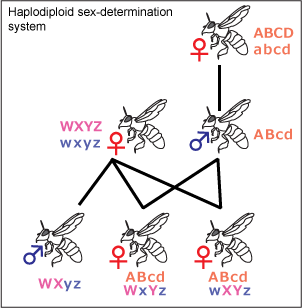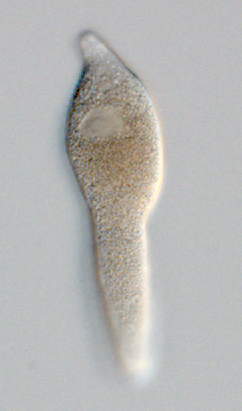|
Lasioglossum Zephyrum
''Lasioglossum zephyrus'' is a sweat bee of the family Halictidae, found in the U.S. and Canada. It appears in the literature primarily under the misspelling "''zephyrum''". It is considered a primitively eusocial bee (meaning that they do not have a permanent division of labor within colonies),Batra, S. W. T. 1966. The life cycle and behavior of the primitively social bee ''Lasioglossum zephyrum'' (Halictidae). Univ. Kansas Sci. Bull. 46:359–423. although it may be facultatively solitary (i.e., displaying both solitary and eusocial behaviors).Interactions in colonies of primitively social bees: Artificial colonies of ''Lasioglossum zephyrum '. ''PNAS''. Retrieved 08-27-2011. The species nests in burrows in the soil. Taxonomy and phylogeny |
Animal
Animals are multicellular, eukaryotic organisms in the Kingdom (biology), biological kingdom Animalia. With few exceptions, animals Heterotroph, consume organic material, Cellular respiration#Aerobic respiration, breathe oxygen, are Motility, able to move, can Sexual reproduction, reproduce sexually, and go through an ontogenetic stage in which their body consists of a hollow sphere of Cell (biology), cells, the blastula, during Embryogenesis, embryonic development. Over 1.5 million Extant taxon, living animal species have been Species description, described—of which around 1 million are Insecta, insects—but it has been estimated there are over 7 million animal species in total. Animals range in length from to . They have Ecology, complex interactions with each other and their environments, forming intricate food webs. The scientific study of animals is known as zoology. Most living animal species are in Bilateria, a clade whose members have a Symmetry in biology#Bilate ... [...More Info...] [...Related Items...] OR: [Wikipedia] [Google] [Baidu] |
Haploidy
Ploidy () is the number of complete sets of chromosomes in a cell (biology), cell, and hence the number of possible alleles for Autosome, autosomal and Pseudoautosomal region, pseudoautosomal genes. Sets of chromosomes refer to the number of maternal and paternal chromosome copies, respectively, in each homologous chromosome pair, which chromosomes naturally exist as. Somatic cells, Tissue (biology), tissues, and Individual#Biology, individual organisms can be described according to the number of sets of chromosomes present (the "ploidy level"): monoploid (1 set), diploid (2 sets), triploid (3 sets), tetraploid (4 sets), pentaploid (5 sets), hexaploid (6 sets), heptaploid or septaploid (7 sets), etc. The generic term polyploidy, polyploid is often used to describe cells with three or more chromosome sets. Virtually all sexual reproduction, sexually reproducing organisms are made up of somatic cells that are diploid or greater, but ploidy level may vary widely between different or ... [...More Info...] [...Related Items...] OR: [Wikipedia] [Google] [Baidu] |
Parasitoid
In evolutionary ecology, a parasitoid is an organism that lives in close association with its host (biology), host at the host's expense, eventually resulting in the death of the host. Parasitoidism is one of six major evolutionarily stable strategy, evolutionary strategies within parasitism, distinguished by the fatal prognosis for the host, which makes the strategy close to predation. Among parasitoids, strategies range from living inside the host (''endoparasitism''), allowing it to continue growing before emerging as an adult, to Paralysis, paralysing the host and living outside it (''ectoparasitism''). Hosts can include other parasitoids, resulting in hyperparasitism; in the case of oak galls, up to five levels of parasitism are possible. Some parasitoids Behavior-altering parasite, influence their host's behaviour in ways that favour the propagation of the parasitoid. Parasitoids are found in a variety of Taxon, taxa across the insect superorder Endopterygota, whose compl ... [...More Info...] [...Related Items...] OR: [Wikipedia] [Google] [Baidu] |
Pseudomethoca Frigida
''Pseudomethoca'' is a genus of velvet ants in the family Mutillidae. There are at least 20 described species in ''Pseudomethoca''. Species These 24 species belong to the genus ''Pseudomethoca'': * '' Pseudomethoca anthracina'' * '' Pseudomethoca athamas'' * '' Pseudomethoca bequaerti'' (striped velvet ant) * '' Pseudomethoca brazoria'' * '' Pseudomethoca contumax'' * '' Pseudomethoca diligibilis'' Mickel, 1952 * '' Pseudomethoca donaeanae'' * '' Pseudomethoca flammigera'' * '' Pseudomethoca frigida'' * '' Pseudomethoca oceola'' * '' Pseudomethoca oculata'' * '' Pseudomethoca paludata'' * '' Pseudomethoca pergrata'' Cresson, 1902 * '' Pseudomethoca plagiata'' (Gerstäcker, 1874) * '' Pseudomethoca praeclara'' * '' Pseudomethoca propinqua'' (Cresson, 1865) * '' Pseudomethoca puchella'' Mickel, 1952 * '' Pseudomethoca pumila'' Burmeister, 1855 * '' Pseudomethoca quadrinotata'' * '' Pseudomethoca sanbornii'' * '' Pseudomethoca simillima'' (Smith, 1855) * '' Pseudomethoca torrida'' K ... [...More Info...] [...Related Items...] OR: [Wikipedia] [Google] [Baidu] |
Mutillidae
The Mutillidae are a family of more than 7,000 species of wasps whose wingless females resemble large, hairy ants. Their common name velvet ant refers to their dense pile of hair, which most often is bright scarlet or orange, but may also be black, white, silver, or gold. Their bright colors serve as aposematic signals. They are known for their extremely painful stings, (the sting of the species ''Dasymutilla klugii'' rated a 3 on the Schmidt pain index and lasts up to 30 minutes), and has resulted in the common name "cow killer" or "cow ant" being applied to the species '' Dasymutilla occidentalis.'' However, mutillids are not aggressive and sting only in defense. In addition, the actual toxicity of their venom is much lower than that of honey bees or harvester ants. Unlike true ants, they are solitary, and lack complex social systems. Distribution Mutillidae can be found worldwide with about 230 genera or subgenera and around 8,000 species worldwide. Over 400 species occur ... [...More Info...] [...Related Items...] OR: [Wikipedia] [Google] [Baidu] |
Kleptoparasite
Kleptoparasitism (etymologically, parasitism by theft) is a form of feeding in which one animal deliberately takes food from another. The strategy is evolutionarily stable when stealing is less costly than direct feeding, which can mean when food is scarce or when victims are abundant. Many kleptoparasites are arthropods, especially bees and wasps, but including some true flies, dung beetles, bugs, and spiders. Cuckoo bees are specialized kleptoparasites which lay their eggs either on the pollen masses made by other bees, or on the insect hosts of parasitoid wasps. They are an instance of Emery's rule, which states that insect social parasites tend to be closely related to their hosts. The behavior occurs, too, in vertebrates including birds such as skuas, which persistently chase other seabirds until they disgorge their food, and carnivorous mammals such as spotted hyenas and lions. Other species opportunistically indulge in kleptoparasitism. Strategy Kleptoparasitism is a ... [...More Info...] [...Related Items...] OR: [Wikipedia] [Google] [Baidu] |
Lasioglossum Cephalotes
The sweat bee genus ''Lasioglossum'' is the largest of all bee genera, containing over 1700 species in numerous subgenera worldwide.Gibbs, J., et al. (2012)Phylogeny of halictine bees supports a shared origin of eusociality for ''Halictus'' and ''Lasioglossum'' (Apoidea: Anthophila: Halictidae).''Molecular Phylogenetics and Evolution'' 65(3), 926-39. They are highly variable in size, coloration, and sculpture; among the more unusual variants, some are cleptoparasites, some are nocturnal, and some are oligolectic. Most ''Lasioglossum'' species nest in the ground, but some nest in rotten logs. Social behavior among species of ''Lasioglossum'' is extraordinarily variable; species are known to exhibit solitary nesting, primitive eusociality, and social parasitism. Colony sizes vary widely, from small colonies of a single queen four or fewer workers to large colonies of >400 workers and perennial life cycles. The genus ''Lasioglossum'' can be divided ... [...More Info...] [...Related Items...] OR: [Wikipedia] [Google] [Baidu] |
Gregarinasina
The gregarines are a group of Apicomplexan alveolates, classified as the Gregarinasina or Gregarinia. The large (roughly half a millimeter) parasites inhabit the intestines of many invertebrates. They are not found in any vertebrates. However, gregarines are closely related to both ''Toxoplasma'' and ''Plasmodium'', which cause toxoplasmosis and malaria, respectively. Both protists use protein complexes similar to those that are formed by the gregarines for gliding motility and invading target cells. This makes them excellent models for studying gliding motility with the goal of developing treatment options for toxoplasmosis and malaria. Thousands of different species of gregarines are expected to be found in insects, and 99% of these gregarines still need to be described. Each insect can be the host of multiple species. One of the most studied gregarines is ''Gregarina garnhami''. In general, gregarines are regarded as very successful parasites, as their hosts are spread over the ... [...More Info...] [...Related Items...] OR: [Wikipedia] [Google] [Baidu] |
Asian Hornet (Vespa Velutina) & Mermithid Nematode (black Background)
The Asian hornet (''Vespa velutina''), also known as the yellow-legged hornet or Asian predatory wasp, is a species of hornet indigenous to Southeast Asia. It is of concern as an invasive species in some other countries. Appearance ''Vespa velutina'' is significantly smaller than the European hornet. Typically, queens are 30 mm (1.2 in) in length, and males about 24 mm (0.95 in). Workers measure about 20 mm (0.80 in) in length. The species has distinctive yellow tarsi (legs). The thorax is a velvety brown or black with a brown abdomen. Each abdominal segment has a narrow posterior yellow border, except for the fourth segment, which is orange. The head is black and the face yellow. Regional forms vary sufficiently in color to cause difficulties in classification, and several subspecies have been variously identified and ultimately rejected; while a history of recognizing subspecies within many of the ''Vespa'' species exists, including ''V. ve ... [...More Info...] [...Related Items...] OR: [Wikipedia] [Google] [Baidu] |
Nematode
The nematodes ( or grc-gre, Νηματώδη; la, Nematoda) or roundworms constitute the phylum Nematoda (also called Nemathelminthes), with plant-Parasitism, parasitic nematodes also known as eelworms. They are a diverse animal phylum inhabiting a broad range of environments. Less formally, they are categorized as Helminths, but are taxonomically classified along with Arthropod, arthropods, Tardigrade, tardigrades and other moulting animalia, animals in the clade Ecdysozoa, and unlike platyhelminthe, flatworms, have tubular digestion, digestive systems with openings at both ends. Like tardigrades, they have a reduced number of Hox genes, but their sister phylum Nematomorpha has kept the ancestral protostome Hox genotype, which shows that the reduction has occurred within the nematode phylum. Nematode species can be difficult to distinguish from one another. Consequently, estimates of the number of nematode species described to date vary by author and may change rapidly over ... [...More Info...] [...Related Items...] OR: [Wikipedia] [Google] [Baidu] |
Xyris Tennesseensis
''Xyris tennesseensis'' is a rare species of flowering plant in the family Xyridaceae known by the common name Tennessee yellow-eyed grass. It is native to a small section of the Southeastern United States, including parts of the states of Alabama, Georgia, and Tennessee. A federally listed endangered species, it is threatened by the loss and degradation of its habitat. ''Xyris tennesseensis'' is a perennial herb growing tall. The branching stem is bulbous and fleshy at the base. The leaves are long and narrow and originate at the swollen stem base. They are up to 45 centimeters (18 inches) long and not more than a centimeter (0.4 inch) 45/2.5wide. They are flat but sometimes twisted, and green with reddish or pink bases.''Xyris tennesseensis''. ''Flora of North America''. Retrieved August 27, 2011. The ... [...More Info...] [...Related Items...] OR: [Wikipedia] [Google] [Baidu] |
Diploidy
Ploidy () is the number of complete sets of chromosomes in a cell, and hence the number of possible alleles for autosomal and pseudoautosomal genes. Sets of chromosomes refer to the number of maternal and paternal chromosome copies, respectively, in each homologous chromosome pair, which chromosomes naturally exist as. Somatic cells, tissues, and individual organisms can be described according to the number of sets of chromosomes present (the "ploidy level"): monoploid (1 set), diploid (2 sets), triploid (3 sets), tetraploid (4 sets), pentaploid (5 sets), hexaploid (6 sets), heptaploid or septaploid (7 sets), etc. The generic term polyploid is often used to describe cells with three or more chromosome sets. Virtually all sexually reproducing organisms are made up of somatic cells that are diploid or greater, but ploidy level may vary widely between different organisms, between different tissues within the same organism, and at different stages in an organism's life cycle. Half ... [...More Info...] [...Related Items...] OR: [Wikipedia] [Google] [Baidu] |




.jpg)

_(2).jpg)